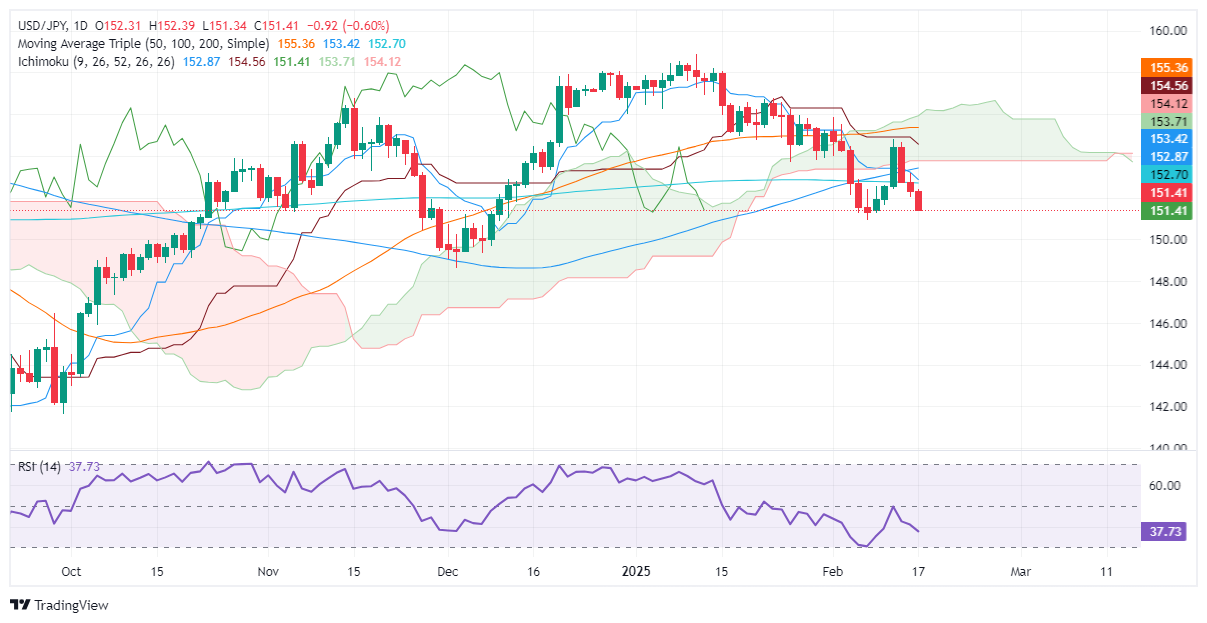USD/JPY Price Forecast: Slips below 152.00 as bearish momentum builds
- USD/JPY eyes February 7 low of 150.93 as downtrend resumes.
- RSI signals further weakness; potential drop to 148.64 if support breaks.
- Upside limited unless buyers reclaim 152.00 and 200-day SMA at 152.70.
The USD/JPY retreats during the North American session and trades below the 200-day Simple Moving Average (SMA) of 152.70 for the second consecutive trading day. Thin liquidity conditions due to a holiday in the United States (US) keep the pair trading subdued below the 151.50 mark.
USD/JPY Price Forecast: Technical outlook
The USD/JPY downtrend resumed on Monday, with the pair dropping below 152.00. Sellers are eyeing a test of the latest cycle low, reached on February 7 at 150.93, which, once cleared, could pave the way for a 200 pip fall to challenge the December 3 swing low of 148.64.
The Relative Strength Index (RSI) remains bearish, favoring a further USD/JPY downside.
Conversely, if USD/JPY climbs past 152.00, buyers could test the 200-day SMA at 152.70. On further strength, the next resistance would be 153.00, ahead of the Senkou Span B at 153.73.
USD/JPY Price Chart – Daily
Japanese Yen FAQs
The Japanese Yen (JPY) is one of the world’s most traded currencies. Its value is broadly determined by the performance of the Japanese economy, but more specifically by the Bank of Japan’s policy, the differential between Japanese and US bond yields, or risk sentiment among traders, among other factors.
One of the Bank of Japan’s mandates is currency control, so its moves are key for the Yen. The BoJ has directly intervened in currency markets sometimes, generally to lower the value of the Yen, although it refrains from doing it often due to political concerns of its main trading partners. The BoJ ultra-loose monetary policy between 2013 and 2024 caused the Yen to depreciate against its main currency peers due to an increasing policy divergence between the Bank of Japan and other main central banks. More recently, the gradually unwinding of this ultra-loose policy has given some support to the Yen.
Over the last decade, the BoJ’s stance of sticking to ultra-loose monetary policy has led to a widening policy divergence with other central banks, particularly with the US Federal Reserve. This supported a widening of the differential between the 10-year US and Japanese bonds, which favored the US Dollar against the Japanese Yen. The BoJ decision in 2024 to gradually abandon the ultra-loose policy, coupled with interest-rate cuts in other major central banks, is narrowing this differential.
The Japanese Yen is often seen as a safe-haven investment. This means that in times of market stress, investors are more likely to put their money in the Japanese currency due to its supposed reliability and stability. Turbulent times are likely to strengthen the Yen’s value against other currencies seen as more risky to invest in.




